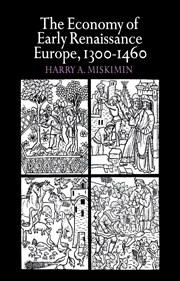2 - THE AGRARIAN ECONOMY
Published online by Cambridge University Press: 29 January 2010
Summary
TOPOGRAPHY
Dramatic and imposing as the actions of princes, popes, and nobles may be, and as significant as the interactions among them are for economic behavior and accomplishment in the later Middle Ages, one must not forget that the greatest portion of the population, perhaps nine-tenths, were agricultural workers. Agriculture was by far the predominant economic activity during this period, and it remained so until well into the nineteenth century. It was upon an agricultural base that medieval society was constructed, and it was the peasant, through his humble labors, who created the conditions that made possible the intellectual and cultural triumphs of the Middle Ages. The importance of agriculture is self-evident. How, then, was it conducted? What conditions determined its success and its organization? In order to seek answers, we must begin with certain elementary facts regarding the physical configurations of the European continent.
A glance at a contour map of Europe reveals two distinct relief patterns that run in an east–west direction and divide the continent into two regions along a line placed roughly between 45 and 50 degrees latitude. Most of Spain, southeastern France, Switzerland, most of Italy with the exception of the Po Valley, Greece, the Balkan Peninsula below the Carpathian mountains but excluding the Danube Basin, and much of Asia Minor comprise mountainous regions with elevations generally greater than fifteen hundred feet above sea level. To the north, starting with southern England and the western coast of France and then continuing in a wedge widening to include the coast of Sweden, a great plain extends to the Urals in the east and to the Caucasus in the south.
- Type
- Chapter
- Information
- The Economy of Early Renaissance Europe, 1300–1460 , pp. 14 - 72Publisher: Cambridge University PressPrint publication year: 1975

